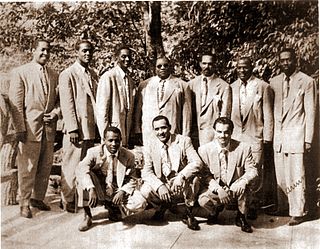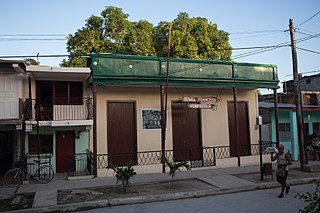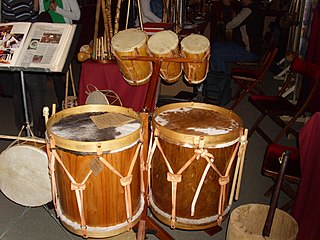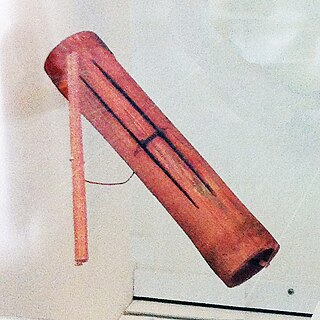Related Research Articles
The term rumba may refer to a variety of unrelated music styles. Originally, "rumba" was used as a synonym for "party" in northern Cuba, and by the late 19th century it was used to denote the complex of secular music styles known as Cuban rumba. Since the early 20th century the term has been used in different countries to refer to distinct styles of music and dance, most of which are only tangentially related to the original Cuban rumba, if at all. The vague etymological origin of the term rumba, as well as its interchangeable use with guaracha in settings such as bufo theatre, is largely responsible for such worldwide polysemy of the term. In addition, "rumba" was the primary marketing term for Cuban music in North America, as well as West and Central Africa, during much of the 20th century, before the rise of mambo, pachanga and salsa.
The music of Cuba, including its instruments, performance, and dance, comprises a large set of unique traditions influenced mostly by west African and European music. Due to the syncretic nature of most of its genres, Cuban music is often considered one of the richest and most influential regional music in the world. For instance, the son cubano merges an adapted Spanish guitar (tres), melody, harmony, and lyrical traditions with Afro-Cuban percussion and rhythms. Almost nothing remains of the original native traditions, since the native population was exterminated in the 16th century.

Arsenio Rodríguez was a Cuban musician, composer and bandleader. He played the tres, as well as the tumbadora, and he specialized in son, rumba and other Afro-Cuban music styles. In the 1940s and 1950s Rodríguez established the conjunto format and contributed to the development of the son montuno, the basic template of modern-day salsa. He claimed to be the true creator of the mambo and was an important as well as a prolific composer who wrote nearly two hundred songs.

Bongos are an Afro-Cuban percussion instrument consisting of a pair of small open bottomed hand drums of different sizes. The pair consists of the larger hembra and the smaller macho, which are joined by a wooden bridge. They are played with both hands and usually held between the legs, although in some cases, as in classical music, they may be played with sticks or mounted on stands.

The conga, also known as tumbadora, is a tall, narrow, single-headed drum from Cuba. Congas are staved like barrels and classified into three types: quinto, tres dos or tres golpes (middle), and tumba or salidor (lowest). Congas were originally used in Afro-Cuban music genres such as conga and rumba, where each drummer would play a single drum. Following numerous innovations in conga drumming and construction during the mid-20th century, as well as its internationalization, it became increasingly common for drummers to play two or three drums. Congas have become a popular instrument in many forms of Latin music such as son, descarga, Afro-Cuban jazz, salsa, songo, merengue and Latin rock.
Charanga is a traditional ensemble that plays Cuban dance music. They made Cuban dance music popular in the 1940s and their music consisted of heavily son-influenced material, performed on European instruments such as violin and flute by a Charanga orchestra.. The style of music that is most associated with a Charanga is termed 'Danzón', and is an amalgam of both European classical music and African rhythms.
Son cubano is a genre of music and dance that originated in the highlands of eastern Cuba during the late 19th century. It is a syncretic genre that blends elements of Spanish and African origin. Among its fundamental Hispanic components are the vocal style, lyrical metre and the primacy of the tres, derived from the Spanish guitar. On the other hand, its characteristic clave rhythm, call and response structure and percussion section are all rooted in traditions of Bantu origin.
The term conga refers to the music groups within Cuban comparsas and the music they play. Comparsas are large ensembles of musicians, singers and dancers with a specific costume and choreography which perform in the street carnivals of Santiago de Cuba and Havana.
Yuka is a secular Afro-Cuban musical tradition which involves drumming, singing and dancing. It was developed in western Cuba by Kongo slaves during colonial times. Yuka predates other Afro-Cuban genres of dance music like rumba and has survived in Kongo communities of Pinar del Río, specifically in El Guayabo and Barbacoa, San Luis. Since the 1940s, yuka performances have been recorded by researchers such as Harold Courlander and María Teresa Linares.

Tumba francesa is a secular Afro-Cuban genre of dance, song, and drumming that emerged in Oriente, Cuba. It was introduced by slaves from the French colony of Saint-Domingue whose owners resettled in Cuba's eastern regions following the slave rebellion during the 1790s. The genre flourished in the late 19th century with the establishment of sociedades de tumba francesa, of which only three survive.

Rumba is a secular genre of Cuban music involving dance, percussion, and song. It originated in the northern regions of Cuba, mainly in urban Havana and Matanzas, during the late 19th century. It is based on African music and dance traditions, namely Abakuá and yuka, as well as the Spanish-based coros de clave. According to Argeliers León, rumba is one of the major "genre complexes" of Cuban music, and the term rumba complex is now commonly used by musicologists. This complex encompasses the three traditional forms of rumba, as well as their contemporary derivatives and other minor styles.
In music of Afro-Cuban origin, tumbao is the basic rhythm played on the bass. In North America, the basic conga drum pattern used in popular music is also called tumbao. In the contemporary form of Cuban popular dance music known as timba, piano guajeos are known as tumbaos.
Carlos Valdés Galán, better known as Patato, was a Cuban conga player. In 1954, he emigrated from La Habana to New York City where he continued his prolific career as a sideman for several jazz and Latin music ensembles, and occasionally as a bandleader. He contributed to the development of the tunable conga drum which revolutionized the use of the instrument in the US. His experimental descarga albums recorded for Latin Percussion are considered the counterpart to the commercial salsa boom of the 1970s. Tito Puente once called him "the greatest conguero alive today".

The bombo criollo, or simply bombo, is a family of Latin American drums derived from the European bass drum and native Latin American drum traditions. These drums are of smaller dimensions than the orchestral bass drum, and their frame can be made of wood or steel. They can be held vertically or diagonally on the body or a stand. The specific make of the instrument depends on the regional tradition. In Argentina, the bombo criollo is called bombo legüero and played in many folkloric styles. In Cuba, bombos are the largest drums played by the street comparsas in Santiago. In other countries, the term tambora is commonly used.

Makuta drums are tall cylindrical or barrel-shaped Afro-Cuban drums, often cited as an important influence on the development of the tumbadora or conga drum. They are used in sacred dance-drumming ceremonies associated with the descendants of slaves brought to Cuba from Central Africa. The word makuta is also used to refer to the dancing and rhythms associated with these drums.

The catá or guagua is a Cuban percussion instrument which originated in the eastern region of the island. It is classified as a directly struck idiophone, traditionally made out of a hollowed tree trunk, which the player hits with wooden sticks or mallets. The resulting sound is dry and penetrating, similar to that of the claves, although with a different pitch. Of Congolese origin, it is an essential instrument in tumba francesa, yuka and some rumba ensembles.

The cajones de rumba are wooden boxes used as rhythmic percussion instruments in some styles of Cuban rumba. There are different types of cajones, namely the cajón tumbadora, the cajón bajo and the cajita, all of which are hand-struck.
Twoubadou music is a popular genre of guitar-based music from Haiti that has a long and important place in Haitian culture. The word comes from troubadour, a medieval poet-musician who wrote and sang songs about courtly love. Like the troubadours of old, the Haitian twoubadou is a singer-composer who accompanies himself on songs that tell about the bitterness and humor of love, often using risqué or suggestive lyrics.
Alberto Zayas Govín was a Cuban rumba singer and songwriter who founded one of the first recorded rumba ensembles, Grupo Afrocubano Lulú Yonkori. He is considered one of the most important guaguancó vocalists/composers in the history of rumba.
References
- ↑ Ortiz, Fernando (1954). Los instrumentos de la música afrocubana, Vol. IV. Havana, Cuba: Cárdenas y cía. p. 109.
- 1 2 3 Orovio, Helio (2004). Cuban Music from A to Z. Bath, UK: Tumi. p. 208. ISBN 0822332124.
- ↑ Miller, Ivor (2009). Voice of the Leopard: African Secret Societies and Cuba. Jackson, MS: University Press of Mississippi. p. 159. ISBN 9781934110836.
- 1 2 3 4 5 6 Ramos Venereo, Zobeyda (2007). "Haitian Traditions in Cuba". In Kuss, Malena (ed.). Music in Latin America and the Caribbean: An Encyclopedic History, Vol. 2. Austin, TX: University of Texas Press. pp. 265–280. ISBN 9780292784987.
- ↑ Courlander, Harold (1942). "Musical Instruments of Cuba". The Musical Quarterly. 28 (2): 238–239. doi:10.1093/mq/XXVIII.2.227.
- ↑ Ortiz (1954). p. 109.
- 1 2 Ortiz (1954). p. 113.
- 1 2 3 Mirabeu, Daniel (2013). "Tradiciones danzario musicales de raices haitianas en el oriente cubano" (PDF). Ritmacuba (in Spanish). Archived from the original (PDF) on June 28, 2016. Retrieved June 1, 2015.
- ↑ Ortiz (1954). p. 157.
- ↑ Fernández, Olga (2005). Solo de música cubana (in Spanish). Quito, Equator: ABYA-YALA. p. 169. ISBN 9789978225226.
- ↑ Mestas, María del Carmen (1998). Pasión de rumbero (in Spanish). Barcelona, Spain: Puvill Libros. p. 13.